The safari – the Swahili word for “long
journey” – was born in Kenya, the former British colony where barons and
plutocrats, maharajas and royalty once paraded across the plains to play out an
expensive, outlawed fantasy. One blistering summer in this land before time,
Paolo R. Reyes was given a rara opportunity to experience Africa in its age of
innocene
“Kristine Hermosa. You know her? She very
beautiful.” The immigration officer at Nairobi’s Jomo Jenyatta International
Airport inquired – qith a mischievous smile – about the semi-retired Philippine
actress as he stamped my passport with a 90-day tourist visa.
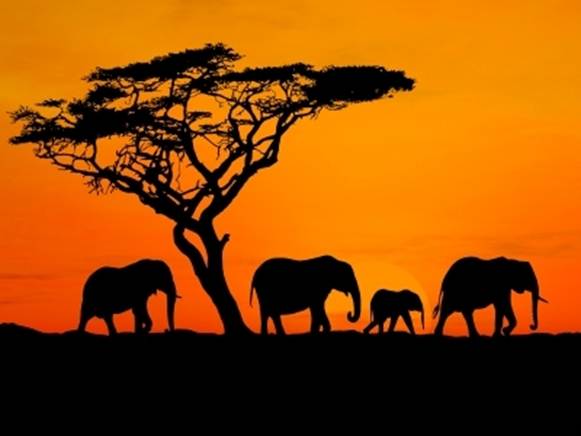
The
safari – the Swahili word for “long journey” – was born in Kenya
I didn’t have time to tell him that I had
interviewed Hermosa for the Inquirer in the past, or that her once-stellar
career had been sidelined by marriage and motherhood. So I flashed him a
similar smile, cracked a corny joke, and took my first step into Kenya: the
land of Out of Arfica safaris, world-class Olympic athletes, Barack
Obama’s forefathers, and, as I soon discovered, defunct Filipino soap operas.
After claiming my luggage at the carousel,
I was met at the arricals hall by Rajab, a representative of my tour operator.
Asia to Africa Safaris, who was to escort my party to the nearby Wilson
airstrip, where a tiny, twinprop De Havilland Otter bound for the wilds of Meru
awaited us.
Before I could even reciprocate Rajab’s
warm “jambo” (Swahili for “hello”), he began interrogating me on what I was
beginning to realize was a local obsession: the dramatic cliffhangers, twisted
storylines, and tantalizing stars of Pangako Sa ‘Yo, Sana’y Wala Nang Wakas,
and Kay Tagal Kang Hinintay.
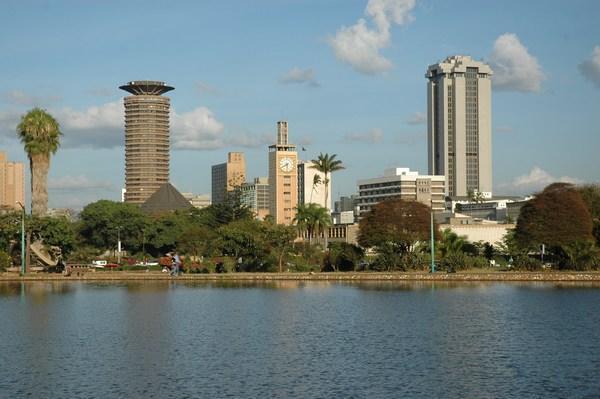
Nairobi
– the capital city of third-world Kenya
These ABS-CBN telenovelas, all dubbed or
subtitled in the vernacular, have taken the East African nation by storm in
recent years, thus giving these expired Pinoy soaps a second life in the
unlikeliest of places.
Perhaps not so unlikely, I thought, as the
air-conditioned van crawled its way to Wilson, inch by inch, through the
winding, honking crush of traffic that Nairobi – the capital city of
third-world Kenya – has become notorious for.
The two airports are only 12 kilometers
apart, so what should have been a 20-minute drive took us nearly an hour. But
it was a good opportunity to get a glimpse of the capital’s working belly, far
removed from the fancy suburb of Karen (named after Out of Africa author Karen
Blixen), where the country’s 1-percent are ensconced post-colonial estates not
far from the Danish writer’s former coffee plantation.
High up in the air, however, Kenya
transforms into a different kind of creature – primal, prehistoric, and capable
of inspiring wonder. As we hovered over game reserves where the grass seemed to
roll on forever, the jangled din of the city dissolved into the gentle lull of
the jungle.
“They’ve pumped so much money into
this place, it’s incredible,” I overheard my seatmate, the Vanity Fair and New
York Times photographer Guillaume Bonn, tell the plussized American woman behind
him as the De Havilland plane made its descent on the $1.25 million Meru
National Park.
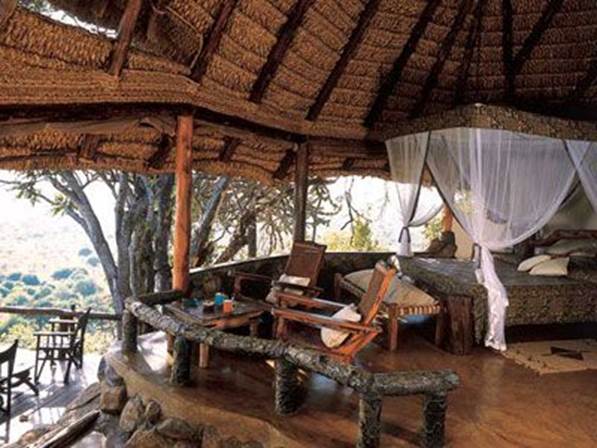
Elsa’s
Kopje - the first stop of my week-long safari, is a cluster of open-faced
casitas built into the jagged folds of Meru’s Mughwango Hill
Bonn, a French photojournalist born in
Madagascar, has covered the dark continent for over a decade, from the murder
of conservationist Joan Root in Lake Naivasha to the Lord’s Resistance Army
(LRA) of fugitive warlord Joseph Kony in North Uganda. (His photographs of the
latter ran alongside a controversial Vanity Fair piece, “childhood’s
End,” written by the late Christopher Hitchens.)
Today, on commission for Condé Nast
Traveler, he was en route to Lewa, the 60,000-acre wildlife consevancy
where Prince William famously proposed marriage to Kate Middleton in a rustic
log cabin overlooking Mount Kenya.
The whirr of the plane’s propellers
prevented me from probing him further. But I gathered from the gruff, inposing
tone of his voice that this was no fluff piece on a five-star ecolodge or
glamping site – which was where I, like most of the khaki-clad holidaymakers on
board the flight, was headed.
Elsa’s Kopje, the first stop of my
week-long safari, is a cluster of open-faced casitas built into the
jagged folds of Meru’s Mughwango Hill, a pyramid of granite marooned in a sea
of thorny thickets. It’s a luxury lodge with a killer view and storied past.
Fifty years ago, before the park was nearly
destroyed by bandit gangs that swept down from Somalia in search of ivory and
rhino horn, this was the lair of Elsa the Lioness. The eccentric Adamsons,
George and Joy, hand-raised the orphaned cub like their own child and
reluctantly released her into the wilderness – a heart-wrenching tale of two
conservationists that was immortalized in the 1966 movie Born Free.
Looking out from the balcony of my cotage,
dramatically perched on a drooping lip of the kopje (small moutain), I
understood how John Barry had been inspired to compose the epic film’s
Oscar-winning score. Down below, on a corn-colored earth specked green with
doum palms and baobab trees, Rothschild giraffes and Grevy’s zebras were
cantering away in the twilight, as a thirsty herd of elephants dipped their
trunks into the Rojewero river, one of 13 tributaries that bisect the park like
tea-brown ribbons.
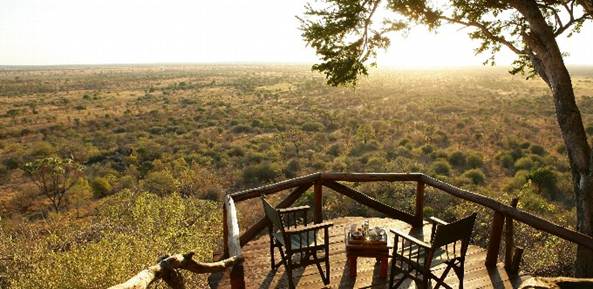
Looking
out from the balcony of my cotage, dramatically perched on a drooping lip of
the kopje (small moutain), I understood how John Barry had been inspired to
compose the epic film’s Oscar-winning score
Francis Epong, a native of the Turkana
tribe, served as our guide at Elsa’s Kopje. Tall, weather-beaten, and hardened
by the harsh climate, he was a throwback to the days of the white hunter and
the memsahib (colonial women) – always ready to cater to our group’s
varied whims, whether it was a champagne breakfast in the bush or a request to
rifle through the forest to search for the elusive leopard.
As with most safaris, our days at Elsa’s
began before the crack of dawn, while the stars were still visible and as the
mists rolled back slowly in the sunrise; a magical hour for bush walks and game
drives, when the landscape and all it’s the living creatures seemed to be in
the process of being created.
The day ended, more often than not, with a
sundowner at dusk, in an open-sided Land Rover well-stocked with wine and
liquor. Upon returning to the lodge, the walinzi (night watchmen) would
lead us to the clubhouse at the windy crag of Mughwango Hill, where a
multi-course Italian dinner would be served under an intermittent shower of
meteors.
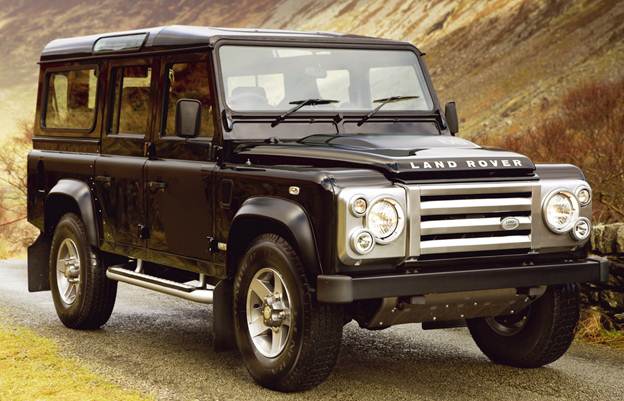
The
day ended, more often than not, with a sundowner at dusk, in an open-sided Land
Rover well-stocked with wine and liquor.
Canopied under this cloudless sky the color
of midnight, you will sometimes hear – if you’re lucky – the guttural moan of a
wandering lioness, as if the ghost of George and Joy Adamson’s Elsa still
haunted the savannah into which she was released.
After Two Spine-Crunching hours on highways
that have seen better days, and a quick stopover at Isiolo, a sleepy backwater
town where the men chewed on miraa (a herbal amphetamine), I finally
arrived at the east gate of Shaba, a 59,000-acre reserve where the reality show
Surivor: Africa was shot 10 years ago.
As my driver left the Land Rover to pay the
entrance fee at the ranger’s station, I played a game with a few persistent
locals, mostly children, who were peddling all manner of trinkets, nacklaces,
and carved animal figurines outside my window.
“I will buy something if you can guess
which country I’m from,” I declared, as the crowd, their faces pressed against
the glass, gathered around the jeep like a friendly mob. They couldn’t, even
with my clues. When I pacified their growing frustration by shouting
“Philippines!” they erupted in laughter, still puzzled perhaps by the odd
provenence of this passing stranger.
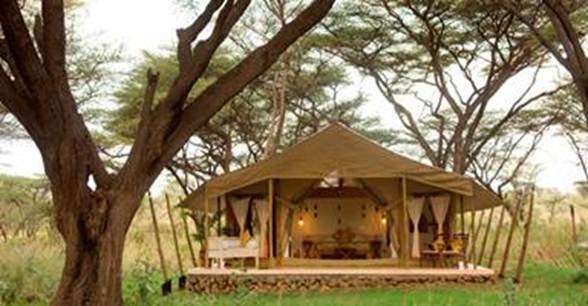
The
Boran-style tent suite of glamping resort Joy’s Camp
In Shaba, the equatorial sun doesn’t so
much shine as strike. But its Martian landscape, unchanged for thousnands of
years, makes up for the blistering heat. In this parched corner of Kenya’s
northern frontier, not far from Ethiopia, the Pleistocene Era anjoys a kind of
eternal life: the volcanic mountain ranges of Bodich and Ol Kanjo swoop up
theatrically from the savannah, where rust-colored boulders the size of buses
are scattered on the red earth like forgotten dinosaur eggs.
For this second leg of the safari, I was
lodged at Joy’s Camp, a lowkey “glamping” resort. In the late 1970s, Joy
Adamson called this remote corner of the reserve her home. It was then a
ramshackle of tables and chairs, paint brushes and paper where she wrote her
final book, The Queen of Shaba, and was mysteriously murdered in the
summer of 1980. A concrete cairn, just behind the camp, marks the spot where
she was slain.
If you’re looking for isolation – a real
selling point for seasoned safari-goers – Joy’s Camp is the place to find it.
Managed by Willem Dolleman and Francien van de Vijver, an eco-conscious Dutch
couple in their late twenties, the camp os made of up 10 tented suites, all
designed around an exotic Moorish theme inspired by the local Boran tribe.
The main dining tent, a Mediterranean-style
oasis with a springwater swimming pool, overlooks a veritable Garden of Eden –
a lush green plain with a large natural spring where lions, reticulated
giraffes, and elephants vie for watering rights with buffalo, Beisa oryx, and
zebras.
To truly appreciate the volcanic terrain of
Shaba, you must confront nature on your own feet. Instead of a game drive on my
final day, I opted for a treacherous trek through the Ewaso Nyiro River’s
unforgiving gorge: a daredevil’s playground of predators, abandoned poachers’
caves, and poisonous plants that can render a man blind.
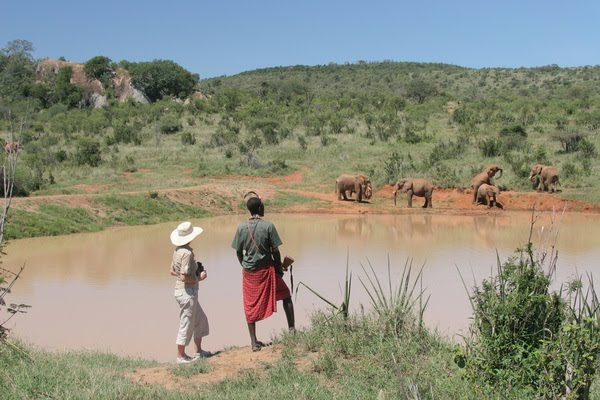
The
Ewaso Nyiro River
Together with my guide, John Ebukutt, and
an armed game scout in military fatigue (“Whatever you do, don’t run,” he
warned me), we trudged cautiously through the steep ochre wall of the ravine,
the river’s chocolate-brown waters surging 40 feet below us, until we clawed
our way down to a sandy beach, where we could make out the spoor of freshwater
Nile crocodiles and the footprints of baboons.
At the flat crown of the canyon, we came
face-to-face with the prehistoric panorama of Shaba: a sweeping, grandstand
view of Creation, the kind one imagines God might have had on the third day.
Even in the blinding haze of high noon, it was possible to imagine what it must
have looked like in the beginning.
The Story Goes that when John Galliano, the
disgraced British fashion designer, first set foot on Elephant Pepper – a
traditional campsite in the beating heart of the bush – his jaw dropped upon
catching sight of his “suite.”
Canopied under a grove of pepper trees
where Vervet monkeys played and found, and garrisoned by a row of Maasai
tribesmen clad in Shuka blankets, was a bare-bones canvas tent with a backyard
unlike any other: the game-rich grasslands of the Maasai Mara, Kenya’s most
famous wildlife reserve.
The witnesses I spoke to couldn’t confirm
whether Galliano raised his sculpted eyebrows in delight or disbelief. But for
most first-item guests at Elephant Pepper Camp, the third and final leg of my
Kenyan safari, it’s usually a mix of both.
With limited mobile phone access, no
generators (twelve solar panels power the entire site, when needed), no
permanent structures (mindful of their eco-footprint, everything is completely
mobile), and an unfenced location inhabited by all creatures wild and free,
Elephant Pepper Camp offers what most five-star African lodges cannot: an
opportunity to experience Kenya in its age of innocence.
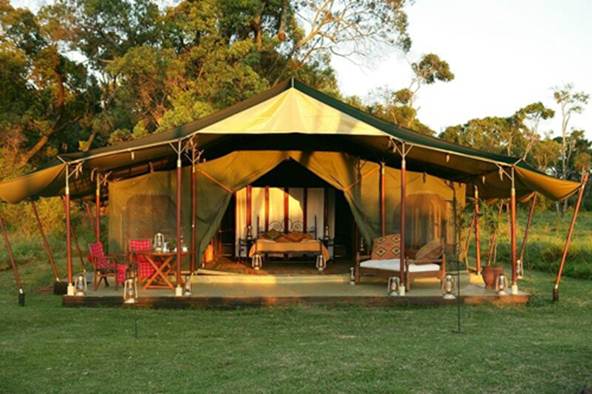
Elephant
Pepper Camp
The Mara, once the world’s most popular
playground for hunters and poachers, was where this European pastime of
game-viewing began in the 19th century. In those days, when
well-heeled Westerners with a sense of adventure went on “safari” (the Swahili
word for “journey”), it mean long, treacherous nights on horse-drawn caravans
with a huge contingent of staff and crew ready to pitch a tent and prepare a
campfire come nightfall.
When I arrived during the waning days of
Kenya’s blistering summer, under billowing clouds pregnant with rain, I
realized just how easy it was for writers like Heming way or Huxley to wax
romantic about those halcyon days of the hunt.
Gone, of course, were the crackling sounds
of rifles being fired in the air and the constant drumming of hoofbeats in the
red dirt. As I sat under a ceiling of stars, enjoying my cold glass of Tusker
beer over the campfire, there was only the deafening silence of the night,
interrupted only by a falcon’s contact call in the distance or the deep-throated
roar of a lion.
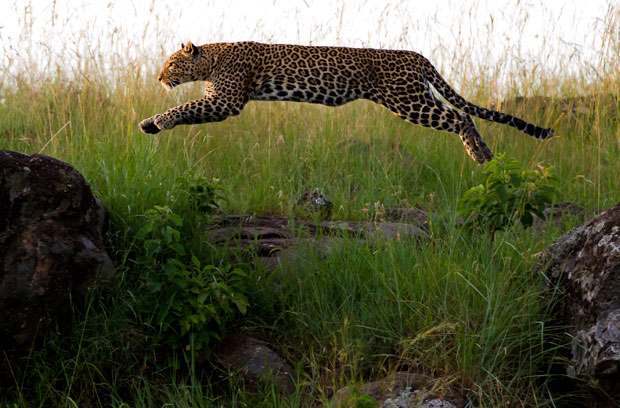
On
a clearing close to the Leopard Gorge, my guide Stanley Kipkoske called my
attention to a cheetah rustling like a ravenous predator through the grass, her
gaze directed at a helpless prey
The old-fashioned charm of this 20-year-old
mobile camp is its accommodations. Linked together by hurricane lamps and
marked footpaths in the forest, each of the eight canvas tents consist of a
queen-sized bed, an en-suite bathroom (with a wash basin, bucket shower, and
eco-friendly flush toilet), and a private veranda with a hammock perfect for
noontime naps between game drives.
Game drives are the highlight of any safari
in the Mara, a savannah so flat, leveled, and free of obstruction that it
offers camera- and binocular-friendly views of the big cats, wildebeests,
zebras, giraffes, gazelles, and spotted hyenas on parade.
I can still recall the inimitable thrill I
felt when I witnessed my first hill. On a clearing close to the Leopard Gorge,
my guide Stanley Kipkoske called my attention to a cheetah rustling like a
ravenous predator through the grass, her gaze directed at a helpless prey: a
baby Thomson’s gazelle that had strayed away from its pack.
A panicked barking, like alarm bells,
erupted from the herd, a futile attempt to warn the wayward fawn of an
impending attack. My telephoto lens closely followed the action from stalk, to
chase, to kill. In the blink of an eye, it was all over. The predator, her
mouth firmly locked on the bleeding neck of its prey, grew increasingly
paranoid as a flock of vultures began circling overhead in a ritualistic dance
of death.
“The law of the jungle,” Stanley said as I
sat motionless at the edge of my seat.
In the wild, primitive corner of Arica, a
land before time where man stills seems beholden to the beasts of a bygone
world, nature – and not much else – puts on the greatest show on earth.